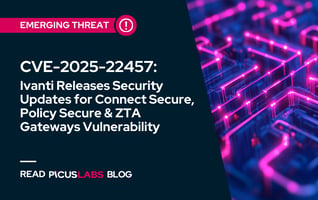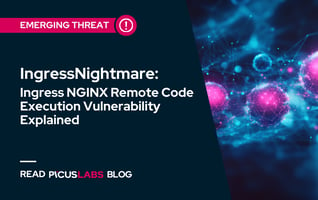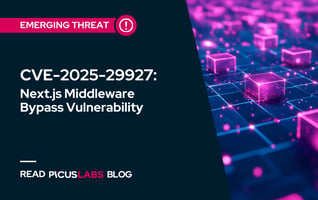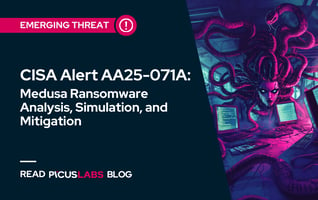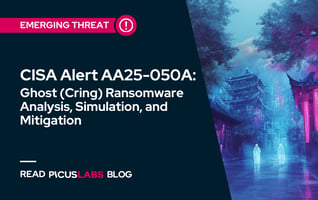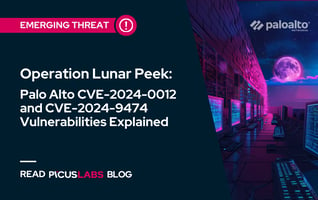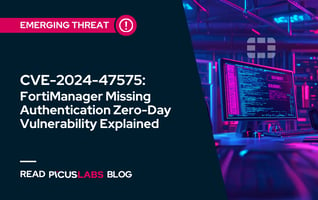ALPHV Ransomware: Analyzing the BlackCat After Change Healthcare Attack
The ALPHV ransomware group, also known as BlackCat, emerged in November 2021 as a sophisticated cybercrime organization operating under a Ransomware-as-a-Service (RaaS) model. In February 2024, they attacked UnitedHealth Group's subsidiary, Change Healthcare, leading to significant disruptions in the U.S. healthcare sector. UnitedHealth paid a $22 million ransom to ALPHV following the attack. The breach compromised the personal information of over 100 million individuals, marking the largest healthcare data breach in U.S. history. The U.S. Department of State has offered rewards of up to $10 million for information leading to the identification or location of ALPHV/BlackCat leaders.
In this blog, we are going to deep dive into the tactics, techniques, and procedures of the ALPHV ransomware group.
The Analysed Malware Sample of BlackCat (ALPHV) Ransomware
The analysis focused on the “Asss1exe.bin” file, whose SHA256 hash can be directly accessed on VirusTotal for manual research. As of the end of January 2025, the malware is still under active analysis, indicating that it continues to be actively used by adversaries.
Observed Names of the Malicious File:
-
Asss1.exe.bin
-
847fb7609f53ed334d5affbb07256c21cb5e6f68b1cc14004f5502d714d2a456.exe (named after hash of the file)
-
Blackcat.exe, Blackcat.bin, BlackCat.bin
-
Trojan-Ransom.Win32.BlackCat.exe
- 362.vir
SHA256: 847fb7609f53ed334d5affbb07256c21cb5e6f68b1cc14004f5502d714d2a456
Affiliates and Ransomware-as-a-Service Model of the ALPHV Ransomware Group
BlackCat operates as a Ransomware-as-a-Service (RaaS) platform, allowing other cybercriminals to use its ransomware in exchange for a share of the profits. While most RaaS models let affiliates retain about 70% of their earnings, BlackCat offers a more generous share, allowing affiliates to keep 80-90% of their profits [1].
According to researchers, this revenue model acts as a powerful advertising tool. While other groups rely on marketing teams or posts on cybercrime forums to attract attention, BlackCat’s higher profit margins generate organic interest and promote the operation through word-of-mouth among affiliates.
However, this strategy has significant implications for potential victims. The affiliates are observed to reinvest their earnings into expanding their operations. By renting more services from BlackCat or hiring other cybercriminals, they can scale their attacks, resulting in greater harm to organizations. This cycle of reinvestment amplifies the overall impact of BlackCat’s operation.
Notable Cyber Incidents & Victimology of the BlackCat/ALPHV Ransomware Group
The ALPHV ransomware group, also known as BlackCat, has been linked to several significant cyber incidents, demonstrating their evolving tactics and the substantial impact of their operations.
Notable cases include:
-
Change Healthcare Breach (February 2024): In February 2024, Change Healthcare, a subsidiary of UnitedHealth Group, suffered a ransomware attack attributed to the BlackCat group. This breach compromised the personal information of over 100 million individuals, making it the largest healthcare data breach in U.S. history. The stolen data included health insurance member IDs, patient diagnoses, treatment information, and Social Security numbers. UnitedHealth paid a $22 million ransom in response to the attack [2].
-
Reddit Data Breach (February 2023): In February 2023, Reddit experienced a security incident where BlackCat claimed to have stolen 80 GB of compressed data [3]. The group demanded a $4.5 million ransom for the data's return. Unlike typical ransomware attacks, this incident did not involve data encryption but focused on data exfiltration and extortion.
-
MGM Resorts and Caesars Entertainment Attacks (September 2023): In September 2023, BlackCat, in collaboration with the Scattered Spider group, launched ransomware attacks against major casino operators MGM Resorts International and Caesars Entertainment [4]. Caesars paid a $15 million ransom, while MGM chose not to pay, leading to system shutdowns and an estimated financial impact of $100 million in the third quarter of 2023.
Analyzing BlackCat Ransomware's Advanced Tactics, Techniques, and Procedures (TTPs)
This section provides a comprehensive analysis of these TTPs, offering insights into how BlackCat/ALPHV Ransomware operates and the tools they employ.
Initial Access - ATT&CK TA0001
Phishing for Information - MITRE T1598
ALPHV/BlackCat affiliates conduct thorough open-source intelligence gathering to impersonate IT support staff. They leverage this knowledge to contact employees through phone calls and SMS messages, creating convincing scenarios that appear to require urgent technical support interaction.
Account Access Development - MITRE T1586
Through these impersonation efforts, the threat actors manipulate employees into providing their network credentials. By posing as internal IT personnel and creating realistic support scenarios, they obtain valid credentials that provide them with legitimate initial access to the target network.
Execution - ATT&CK TA0002
Command and Scripting Interpreter: Windows Command Shell - MITRE T1059.003
Malware, “847fb7…”.exe (truncated for better readability) is executed via the command line with specific parameters that dictate its behavior and execution [5].
The example syntax for malware to be executed is as follows.
|
Blackcat.exe --access-token <ACCESS_TOKEN> |
One of the primary execution parameters is the access token, which is a 32-byte value required for the malware to run. If an invalid access token is provided, the malware will output error messages, such as:
|
C:\Users\Desktop>Blackcat.exe Invalid access token. |
This highlights the importance of providing a valid access token for successful execution.
In addition to the access token, the malware accepts several command-line parameters, each controlling different functionalities. Key parameters and their associated purposes include:
|
--help # Display usage information |
The malware also provides features for user-initiated execution, making it more flexible in its deployment:
|
--drag-and-drop # Support for drag and drop execution |
In terms of Living off the Land Binaries (LoLBins), the malware takes advantage of legitimate Windows utilities to carry out critical system commands. This approach is useful for evading detection, as the commands appear as normal system operations. By utilizing native command shells, the malware maintains high privileges while executing malicious activities.
Some of the commands run by the malware are given as follows. More of the examples are also provided throughout the blog.
|
# Retrieve the UUID of the system's product (Hardware identifier) # Set Symlink Evaluation behavior for remote-to-local (R2L) symlinks to enabled (1) |
By using these legitimate system tools, the malware blends in with normal operations while maintaining the necessary privileges to carry out its objectives, such as network discovery, system modification, and process manipulation. This makes detection and mitigation more challenging for security defenses.
Native API - MITRE T1106
Malware extensively uses Windows API for core operations
CreateFileW() API Call & Key Usage by Malware
|
CreateFileW(0x40000000 = GENERIC_WRITE, 0x7 = FILE_SHARE_DELETE | FILE_SHARE_WRITE | FILE_SHARE_READ) |
These permissions ensure the malware can fully control file operations while maintaining shared access.
ReadFile() API Call & Key Usage by Malware
|
# Read the first 4 bytes of target files |
WriteFile() API Call & Key Usage by Malware
|
# Write the 4-byte border marker (19 47 B2 CE): A 4-byte border "19 47 B2 CE" that separates the encrypted file content from the encrypted AES key is written to the file [Encrypted AES Key] [19 47 B2 CE] [Encrypted File Content] # Place ransom notes in directories # Write encrypted content back to files |
Ransomware Note Left by BlackCat Ransomware
CreateThread() API Call & Key Usage by Malware
|
# Creates multiple threads for parallel processing: The threads are created with STACK_SIZE_PARAM_IS_A_RESERVATION (0x00010000) parameter |
Persistence - ATT&CK TA003
Modify Registry - MITRE T1112
The malware modifies specific registry values to optimize its network operations for lateral movement and mass file encryption across network shares.
Maximizes SMB request handling capacity:
The implementation of this registry modification directly impacts the system's ability to handle SMB (Server Message Block) requests by maximizing the number of simultaneous connections that can be processed. By setting the MaxMpxCt value to its highest possible value, 65535, the system can handle up to 65,535 concurrent SMB requests. This significantly increases the network throughput and allows for faster file access and communication across the network, which is critical for operations such as lateral movement and file encryption.
The registry change is made by executing the following command:
|
reg add HKEY_LOCAL_MACHINE\SYSTEM\CurrentControlSet\Services\LanmanServer\Parameters /v MaxMpxCt /d 65535 /t REG_DWORD /f |
Purpose:
- Increases the maximum number of simultaneous SMB requests that can be processed
- Facilitates faster network enumeration and file encryption across shares
- Supports efficient lateral movement using stolen credentials
Sequence of operations:
- Sets MaxMpxCt to maximum (65535)
- Enumerates network using "arp -a"
|
cmd.exe /c "arp -a" |
- Connects to shares using "net use" with stolen credentials
|
net use \\[target_ip]\[share_name] /user:[username] [password] |
- Launches child processes for lateral movement
Privilege Escalation - ATT&CK TA004
Access Token Manipulation - MITRE T1134
The malware manipulates access tokens to gain extensive system privileges, enabling it to perform system-wide modifications and access protected resources. This broad access is essential for comprehensive encryption and system manipulation.
Enables extensive privileges:
|
SeIncreaseQuotaPrivilege |
Valid Accounts - MITRE T1078
The BlackCat malware stores its configuration in a JSON format, which is decrypted at runtime. This configuration file contains stolen credentials specific to the victim's environment, allowing the malware to authenticate itself across the network. The malware uses these credentials to make connections to network shares and further compromise the system.
One of the key methods used by BlackCat to establish connections is through the net use command. This command allows the malware to create SMB connections to network shares using the stolen credentials.
The following command is executed by the malware:
|
net use \\<computer_name> /user:<username> <password> |
Purpose:
- Creates SMB connections to network shares
- Uses stored credentials for authentication
- Makes connections appear as legitimate user activity
By leveraging valid credentials, BlackCat is able to move laterally within the network, escalate privileges, and carry out its malicious objectives while blending in with legitimate network traffic.
Defense Evasion - ATT&CK TA0005
Disable or Modify Tools - MITRE T1562.001
The malware systematically disables system recovery and logging mechanisms to prevent system restoration and hide its activities.
Disabling Windows Event Logging:
|
cmd.exe /c for /F "tokens=*" %1 in ('wevtutil.exe el') DO wevtutil.exe cl %1 |
This command is designed to clear all Windows Event Logs from the system. It works by first using the wevtutil.exe el command to list all available event logs on the system. Then, for each log found, it runs the wevtutil.exe cl command to clear the contents of that log. Essentially, the command iterates through all event logs (e.g., Application, Security, System logs, etc.) and deletes their contents, leaving them empty.
This command is highly problematic as it can cripple forensic investigations and make it nearly impossible to trace malicious actions or identify the root cause of security breaches.
Abuse Elevation Control Mechanism - UAC Bypass: T1548.002
By bypassing User Account Control through the CMSTPLUA COM interface, the malware gains administrative privileges without triggering security prompts. This stealthy elevation of privileges is crucial for performing system-wide encryption and modifications. Breakdown of the technique is as follows:
-
CMSTPLUA COM Interface:
The CMSTPLUA interface allows for the launching of processes with elevated privileges without triggering the usual UAC prompt. By using this interface, malware can silently gain administrative privileges on the system.
-
Initializing COM Library:
The below function call is part of the COM (Component Object Model) initialization process. It ensures the proper threading model is set for COM objects, allowing the malware to interact with COM interfaces correctly, including the auto-elevated CMSTPLUA interface.
|
CoInitializeEx(0x2 = COINIT_APARTMENTTHREADED) |
-
Using the Auto-elevated CMSTPLUA COM Interface with CLSID:
The CLSID (Class Identifier) refers to a unique identifier for the COM object that facilitates the elevation of privileges. By invoking this CLSID, malware can execute commands with higher privileges without the typical UAC prompts.
|
{3E5FC7F9-9A51-4367-9063-A120244FBEC7} |
This method is often used by attackers to bypass UAC, gaining administrative access to the system and enabling them to perform actions such as system-wide encryption (e.g., in ransomware attacks) or making other unauthorized modifications.
Discovery - ATT&CK TA0007
Process Discovery - MITRE T1057
The malware enumerates running processes to identify security tools and other processes that might interfere with its operation, allowing it to target them for termination.
|
CreateToolhelp32Snapshot(0xF = TH32CS_SNAPALL) |
System Information Discovery - MITRE T1082
The malware gathers detailed system information to customize its attack and ensure maximum impact. This reconnaissance helps identify valuable targets and optimize the encryption strategy.
|
GetSystemInfo() |
Impact - ATT&CK TA0040
The following actions are commonly employed by attackers to prevent recovery of a compromised system, thereby increasing the likelihood that the victim will be unable to restore from backups or perform a system recovery.
Inhibit System Recovery - MITRE 1490
|
# Delete all shadow copies on the system silently (without prompts) |
Delete Shadow Copies: The commands vssadmin.exe Delete Shadows /all /quiet and wmic.exe Shadowcopy Delete silently delete all shadow copies on the system.
Shadow copies are often used for backups and system restore points, so their deletion hampers the ability to recover files or restore the system to a previous, uninfected state.
|
# Disable recovery options (to stop automatic system recovery at boot) |
Disable Recovery Options: The command bcdedit /set {default} recoveryenabled No disables the Windows recovery options, preventing the system from automatically attempting recovery or repair at boot.
This makes it much harder for an administrator or user to initiate a recovery process if the system becomes unstable or compromised.
Data Encrypted for Impact - MITRE T1486
The core ransomware functionality encrypts victim data using a sophisticated encryption scheme, making files inaccessible without the decryption key. This creates urgency and pressure to pay the ransom.
Encryption Implementation:
- Uses AES-128 algorithm with aesenc and aesenclast instructions
- Encrypts the AES key with RSA public key from configuration
- Writes encrypted content back to files
File Processing:
- Adds 4-byte file marker: "19 47 B2 CE" to separate encrypted content from encrypted AES key
- Changes file extensions to .uhwuvzu
- Creates intermediary files named "checkpoints-<encrypted file name>" during encryption process
Key Management:
- Generates 16 random bytes for AES key derivation
- Encrypts the key info in JSON format including cipher type and chunk size
- Uses 80 random bytes as border for the JSON data
Service Stop - MITRE T1489
By stopping critical services, the malware ensures files are unlocked for encryption and disrupts business operations, increasing pressure on victims to pay quickly.
|
OpenSCManagerW(0xF003F = SC_MANAGER_ALL_ACCESS) Used to open the Service Control Manager (SCM) with full access rights, allowing the malware to interact with and control services on the system. The SC_MANAGER_ALL_ACCESS permission grants the ability to query, start, stop, and delete services.
Enumerates the list of active Win32 services on the system. The parameters SERVICE_WIN32 and SERVICE_ACTIVE filter the results to only show running services that are of the Win32 type and currently active, identifying critical system services that could be targeted for stoppage.
Once the malware identifies active services, it sends the SERVICE_CONTROL_STOP command to stop them. This effectively disables the service, potentially unlocking files or preventing essential operations from running. Stopping key services (like file sharing or antivirus) increases the impact of ransomware or malware by making files accessible for encryption and interfering with the system's normal function. |
By stopping essential services, the malware not only disrupts business operations but also forces the victim into a position where they may feel pressured to pay a ransom to restore functionality, especially if the affected services are vital for daily operations. This technique is particularly effective in increasing the chances of a successful attack and extortion.
How Does Picus Help Against BlackCat (a.k.a ALPHV) Ransomware Threat Group?
We strongly suggest simulating ransomware groups to test the effectiveness of your security controls against their attacks using the Picus Security Validation Platform.
Picus Threat Library includes the following threats for BlackCat (a.k.a ALPHV) Ransomware.
|
Threat ID |
Threat Name |
Attack Module |
|
75742 |
BlackCat Ransomware Campaign |
Windows Endpoint |
|
93524 |
BlackCat Ransomware Campaign |
Linux Endpoint |
|
54213 |
BlackCat Ransomware Download Threat |
Network Infiltration |
|
92332 |
BlackCat Ransomware Email Threat |
E-mail Infiltration |
Defense Strategies Against the BlackCat Ransomware Group
The BlackCat (ALPHV) ransomware group has been a significant threat to organizations worldwide. To defend against this sophisticated adversary, consider implementing the following strategies:
-
Regular Software Updates and Patch Management: Ensure that all systems, applications, and devices are consistently updated to mitigate vulnerabilities that BlackCat exploits. Promptly applying security patches can prevent unauthorized access.
-
Advanced Endpoint Detection and Response: Deploy EDR, XDR, IDS solutions capable of detecting and responding to suspicious activities indicative of BlackCat attacks. These tools can identify anomalies and provide real-time alerts, enabling swift incident response.
-
User Awareness and Training: Conduct regular training sessions to educate employees about phishing tactics and social engineering methods commonly used by BlackCat. Empowered staff are less likely to fall victim to deceptive schemes.
-
Network Segmentation and Least Privilege Access: Implement network segmentation to limit lateral movement within your infrastructure. Enforce least privilege access controls to ensure users and applications have only the permissions necessary for their roles, reducing the potential impact of a breach.
-
Comprehensive Backup and Recovery Plans: Maintain regular, encrypted backups stored offline or in immutable formats. A robust backup strategy ensures that, in the event of a ransomware attack, critical data can be restored without succumbing to ransom demands.
By adopting these measures, organizations can enhance their resilience against BlackCat ransomware and other evolving cyber threats.
Conclusion
In conclusion, the ALPHV (BlackCat) ransomware group has emerged as a highly sophisticated and disruptive threat in the cybercriminal landscape. With its advanced tactics, techniques, and procedures (TTPs), BlackCat has caused severe damage across various industries, particularly healthcare, by exploiting vulnerabilities for maximum financial gain. Their Ransomware-as-a-Service model has amplified their reach, enabling affiliates to scale attacks and intensify their impact. The group's use of advanced encryption, lateral movement, and evasion techniques highlights the growing need for robust cybersecurity defenses. Organizations must adopt proactive measures and simulate attacks to identify vulnerabilities and strengthen their defenses against such evolving threats.
Indicators of Compromise (IOCs)
SHA256 Hashes
- 0073414C5A03B20F6F255F400291DE67F2A7268C461F90EA6FF0355CA31AF07A
- 0C6F444C6940A3688FFC6F8B9D5774C032E3551EBBCCB64E4280AE7FC1FAC479
- 13828B390D5F58B002E808C2C4F02FDD920E236CC8015480FA33B6C1A9300E31
- 15B57C1B68CD6CE3C161042E0F3BE9F32D78151FE95461EEDC59A79FC222C7ED
- 1AF1CA666E48AFC933E2EDA0AE1D6E88EBD23D27C54FD1D882161FD8C70B678E
- 1B9E17BFBD292075956CC2006983F91E17AED94EBBB0FB370BF83D23B14289FA
- 2020CAE5115B6980D6423D59492B99E6AAA945A2230B7379C2F8AE3F54E1EFD5
- 21162BBD796AD2BF9954265276BFEBEA8741596E8FE9D86070245D9B5F9DB6DA
- 25172A046821BD04E74C15DC180572288C67FDFF474BDB5EB11B76DCE1B3DAD3
- 28D7E6FE31DC00F82CB032BA29AAD6429837BA5EFB83C2CE4D31D565896E1169
- 28F5E949ECAD3606C430CEA5A34D0F3E7218F239BCFA758A834DCEB649E78ABC
- 29549B75A198AD3AEE4F8B9EA328BC9A73EB0E0D07E36775438BBE7268D453F9
- 2CF54942E8CF0EF6296DEAA7975618DADFF0C32535295D3F0D5F577552229FFC
- 3298629DE0489C12E451152E787D294753515855DBF1CE80BFCDED584A84AC62
- 3336BFDE9B6B8EF05F1D704D247A1A8FD0641AFAECC6A71F5CFA861234C4317B
- 38834B796ED025563774167716A477E9217D45E47DEF20FACB027325F2A790D1
- 39EC2834494F384028AD17296F70ED6608808084EF403714CFBC1BFBBED263D4
- 3D7CF20CA6476E14E0A026F9BDD8FF1F26995CDC5854C3ADB41A6135EF11BA83
- 4103CC8017409963B417C87259AF2A955653567CDBF7D5504198DD350F9EF9C1
- 457A2F29D395C04A6AD6012FAB4D30E04D99D7FC8640A9EE92E314185CC741D3
- 4D7DA1654F9047B6C6A9D32564A66684407ED587CBAFFA54EC1185FD73293D3E
- 4E18F9293A6A72D5D42DAD179B532407F45663098F959EA552AE43DBB9725CBF
- 4EE4E1E2CEDF59A802C01FAE9CCFCFDE3E84764C72E7D95B97992ADDD6EDF527
- 4EF1009923FC12C2A3127C929E0AA4515C9F4D068737389AFB3464C28CCF5925
- 53F5C2F70374696FF12ADCAAF1BBBE0E5DD1B1995D98F2E876B0671888B43128
- 59868F4B346BD401E067380CAC69080709C86E06FAE219BFB5BC17605A71AB3F
- 5BAB2BC0843F9D5124B39F80E12AD6D1F02416B0340D7CFEC8CF7B14CD4385BF
- 5D1817065266822DF9FA6E8C5589534E031BB6A02493007F88D51A9CFB92E89B
- 5DC8B08C7E1B11ABF2B6B311CD7E411DB16A7C3827879C6F93BD0DAC7A71D321
- 5F7D438945306BF8A7F35CAB0E2ACC80CDC9295A57798D8165EF6D8B86FBB38D
- 5FAC60F1E97B6EAAE18EBD8B49B912C86233CF77637590F36AA319651582D3C4
- 68BCE3A400721D758560273AE024F61603B8A4986440A8EC9E28305D7E6D02B0
- 6A6CD64FBA34AADAD2DF808B0FCAB89EF26A897040268B24FED694036CC51D6A
- 6DABCF67C89C50116C4E8AE0FAFB003139C21B3AF84E23B57E16A975B7C2341F
- 6F3A02674B6BBF05AF8A90077DA6E496CC47DDA9101493B8103F0F2B4E4FD958
- 726F038C13E4C90976811B462E6D21E10E05F7C11E35331D314C546D91FA6D21
- 731ADCF2D7FB61A8335E23DBEE2436249E5D5753977EC465754C6B699E9BF161
- 73C19EAB8D2AE58DB3968DD7DE0E745DB2D7709859305B113B748BB02494465E
- 74464797C5D2DF81DB2E06F86497B2127FDA6766956F1B67B0DCEA9570D8B683
- 7B2449BB8BE1B37A9D580C2592A67A759A3116FE640041D0F36DC93CA3DB4487
- 7D2E705DCAA9F36FB132B7FF329F61DD5D0393C28DCD53B2BE1E3BA85C633360
- 7E363B5F1BA373782261713FA99E8BBC35DDDA97E48799C4EB28F17989DA8D8E
- 80DD44226F60BA5403745BA9D18490EB8CA12DBC9BE0A317DD2B692EC041DA28
- 8DD64EA7F226D3EB1E857B0086C0668542652CB37F8142DC000272DBD9569E31
- 937D07239CBFEE2D34B7F1FAE762AC72B52FB2B710E87E02FA758F452AA62913
- 94D6395DCAB01250650E884F591956464D582A4F1F5DA948055E6D2F0A215ACE
- 9514035FEA8000A664799E369AE6D3AF6ABFE8E5CDA23CDAFBEDE83051692E63
- 9C5B233EFB2E2A92A65B5EE31787281DD043A342C80C7AC567CCF43BE2F2843F
- 9D346518330EEEFBF288AECA7B2B6243BC158415C7FEE3F2C19694F0E5F7D51C
- B3B1FF7E3D1D4F438E40208464CEBFB641B434F5BF5CF18B7CEC2D189F52C1B6
- BC49622009B29C23EE762FE6F000936EB1C4C1B29496D5382F175C99AD941AAC
- BD337D4E83AB1C2CACB43E4569F977D188F1BB7C7A077026304BF186D49D4117
- BD4876F7EFBD18A03BBB401A5DC77ED68EF95C72A3F7BE83CEF39A4515E0C476
- C2DDB954877DCFBB62FD615A102CE5FA69F4525ABC1884E8FE65B0C2B120CFD4
- C34C5DD4A58048D7FD164E500C014D16BEFA956C0BCE7CAE559081D57F63A243
- C3E5D4E62AE4ECA2BFCA22F8F3C8CBEC12757F78107E91E85404611548E06E40
- C3F8EBC9CFB7EBE1EBBE3A4210753B271FECF73392FEF98519B823A3E7C056C7
- C8B3B67EA4D7625F8B37BA59EED5C9406B3EF04B7A19B97E5DD5DAB1BD59F283
- CD0E941587672AB1517681A7E3B4F93A00020F8C8C8479A76B9E3555BCD04121
- CEFEA76DFDBB48CFE1A3DB2C8DF34E898E29BEC9B2C13E79EF40655C637833AE
- D15CAB3901E9A10AF772A0A1BDBF35B357EE121413D4CF542D96819DC4471158
- D72766A868FEF87C0C073C1EC3B6A92B7DAED7313B81EE6523386049F768B09D
- D8F51DCFE928A1674E8D88029A404005AB826527372422CAC24C81467440FEB0
- DFA8C282178A509346FB0154E6DBD5FBB0B56C38894CE7D244F5CA26D6820E67
- E14BA0FB92E16BB7DB3B1EFAC4B13AEE178542C6994543E7535D8EFAA589870C
- EA1792F689BFE5AD3597C7F877B66F9FCF80D732E5233293D52D374D50CAB991
- F815F5D6C85BCBC1EC071DD39532A20F5CE910989552D980D1D4346F57B75F89
- F837F1CD60E9941AA60F7BE50A8F2AAAAC380F560DB8EE001408F35C1B7A97CB
- F8C08D00FF6E8C6ADB1A93CD133B19302D0B651AFD73CCB54E3B6AC6C60D99C6
- FAB34D1F0F906F64F95B9F244AE1FE090427E606A9C808C720E18E93A08ED84D
- FB242F64EDBF8AE36A4CF5A80BA8F21956409B448EB0380949BB9152373DB981
SHA1 Hashes
- 1B2A30776DF64FBD7299BD588E21573891DCECBE
- 1D345799307C9436698245E7383914B3A187F1EC
- 25EF7044CDF9B7C17253625A2BD5D2D6FEE44227
- 2741C136B92ACA1E890D2B67084C6867D3CBAA87
- 27ACB306BAEC022A974DB50A90F48183541E12FE
- 30C60F18279ED5FD36E3AC2D3BA5DDBDC5D1F624
- 37178DFACCBC371A04133D26A55127CF4D4382F8
- 39300863BCAAD71E5D4EFC9A1CAE118440AA778F
- 3A78CE27A7AA16A8230668C644C7DF308DE6CF33
- 3F85F03D33B9FE25BCFAC611182DA4AB7F06A442
- 41F47F8EE34C9AE7A4BB43B71E3CC85266302E8E
- 42B188E2E015A72ACCC50FCBDE2D2C81F5258D0B
- 448892D5607124FDD520F62FF0BC972DF801C046
- 4831C1B113DF21360EF68C450B5FCA278D08FAE2
- 514DDCF981D7D8684B3AC20E902F5017292D51C5
- 59791EC1C857D714F9B4AD6C15A78191206A7343
- 6F43E6388B64998B7AA7411104B955A8949C4C63
- 794203A4E18F904F0D244C7B3C2F5126B58F6A21
- 79818110ABD52BA14800CDFF39ECA3252412B232
- 7D130ACE197F4148932306FACFC8D71FA8738D86
- 8770132656D4F3D9B973848B89E96FC95D736179
- 8837AD1BAFB56019A46822DA0ED8B468F380C80D
- 8C70191B12F14EED594388C8FBE05EFE6EBAA564
- 9648559769179677C5B58D5619CA8872F5086312
- 994EDC8D183A1A7243790539044D12B80B1D5D84
- A3E4FB487400D99E3A9F3523AEAA9AF5CF6E128B
- AA8EBC0B00D116CFE46245E0BB4A0B5108AADC0F
- B02DB8C2B9614E986E58F6E31BE686B418F9ABA7
- B39C244C3117F516CE5844B2A843EFF1E839207C
- BE8FD3C3507F02785DA6F12C9B21FF73638CDF23
- C1187FE0EADDEE995773D6C66BCB558536E9B62C
- C4CDE794CF4A68D63617458A60BC8B90D99823CA
- C83DA151F26A58AECB24FC6BA4945ACB934EE954
- D241DF7B9D2EC0B8194751CD5CE153E27CC40FA4
- D38C613020CB4616783C8535380E28404F7EAEBF
- E128B01745AE1CB0DE41C1B1C2E7271A172CF696
- E1BC0C7CF030AF31522C1160E0C70DF5CECBB64A
- E43ECD2F6859E4769028FBD7176BB3339393EA22
- E51217EFB6E33FCA9F7C5F51E5C3A4AE50499A37
- E6AB3C595AC703AFD94618D1CA1B8EBCE623B21F
- E97B00EF58FE081170137536F28DF590DBB41A0E
- F5F56413F81E8F4A941F53E42A90BA1720823F15
- FBA4652B6DBE0948D4DADCEBF51737A738CA9E67
- FCE13DA5592E9E120777D82D27E06ED2B44918CF
MD5 Hashes
- 00C3F790F6E329530A6473882007C3E5
- 08FCF90499526A0A41797F8FDD67D107
- 09BC47D7BC5E40D40D9729CEC5E39D73
- 0B1882F719504799B3211BF73DFDC253
- 0DECFD5E200803523C0437FF7AAC7349
- 1138DE370E523E824BBCA92D049A3777
- 1329384DFDCFDE2228DA94E2A042F2B4
- 19E29534FD49DD27D09234E639C4057E
- 1BE7FE8E20F8E9FDC6FD6100DCAD38F3
- 1CA4CBAC895FC3BD12417B77FC6ED31D
- 204F028C983F654BE32B97E849EDEAAB
- 20855475D20D252DDA21287264A6D860
- 24701208C439B00A43908AE39BBF7DE8
- 26239FA16D0350B2224BFB07E37CBD84
- 275DE1EE6E9C11CB920C879BF6A21339
- 2B1B2B271BC78E67BECA2DCD04354189
- 394441AB65754E2207B1E1B457B3641D
- 3A4FDBC642A24A240692F9CA70757E9F
- 4232C065029EB52D1B4596A08568E800
- 47AE17D89C2D9B6ACDC7458F5DF1C6F7
- 4FF5625E6BD063811EC393B315D2C714
- 5548CAA3B8CDD73B3A56F3F102942882
- 5779CEC690B5BBC61687381AE8A8D518
- 581CFC2D4E02A16B9B2F8DCB70A46B8B
- 58393294F21C1006EFE854EFF1B652D5
- 58B4A4EED74FBFBF104D0FFD92207018
- 5CBB08CD26162E8046DF17D15BA6E907
- 637FB65A1755C4B6DC1E0428E69B634E
- 642BF60F06BB043C4A74D0501597CF5E
- 6C2874169FDFB30846FE7FFE34635BDB
- 6C6C46BDAC6713C94DEBBD454D34EFD9
- 72A589DA586844D7F0818CE684948EEA
- 7A1E7F652055C812644AD240C41D904A
- 7A4CB8261036F35FD273DA420BF0FD5E
- 7FF0241B28D766198743D661A2F67620
- 815BB1B0C5F0F35F064C55A1B640FCA5
- 82DB4C04F5DCDA3BFCD75357ADF98228
- 84E3B5FE3863D25BB72E25B10760E861
- 861738DD15EB7FB50568F0E39A69E107
- 91625F7F5D590534949EBE08CC728380
- 99D8C3E7806D71A2B6B28BE525C8E10E
- 9F2309285E8A8471FCE7330FCADE8619
- 9F60DD752E7692A2F5C758DE4EAB3E6F
- A0E9F5D64349FB13191BC781F81F42E1
- A106C1236357C315722DDBD985C5613C
- A768244CA664349A6D1AF84A712083C0
- BF15A998FD84BEE284AE9F7422BDA640
- C12F54A3F91DC7BAFD92CB59FE009A35
- C737A137B66138371133404C38716741
- C850F6816459E3364B2A54239642101B
- D28271ED838464D1DEBAB434EF6D8E37
- D6828E30AB66774A91A96AE93BE4AE4C
- DB7AEB75528663639689F852FD366243
- DBF5F56998705C37076B6CAE5D0BFB4D
- E0D1CF0ABD09D7632F79A8259283288D
- E20FC97E364E859A2FB58D66BC2A1D05
- E7EE8EA6FB7530D1D904CDB2D9745899
- EB64862F1C8464CA3D03CF0A4AC608F4
- EC74A5C51106F0419184D0DD08FB05BC
- EFB019B1999D478A4161A030A5D9302E
- F176BA63B4D68E576B5BA345BEC2C7B7
- F27A9B7C29960AAF911F2885B40536C2
- F4FEBC55EA12B31AE17CFB7E614AFDA8
- F5EF5142F044B94AC5010FD883C09AA7
- FB34B1FB80B053E69D89AF5330CD7D4B
- FCF3A6EEB9F836315954DAE03459716D
References
[1] “Breaking Down the BlackCat Ransomware Operation,” CIS, Jul. 07, 2022. Available: https://www.cisecurity.org/insights/blog/breaking-down-the-blackcat-ransomware-operation. [Accessed: Jan. 16, 2025]
[2] “Change Healthcare Consumer support page.” Available: https://www.unitedhealthgroup.com/ns/health-data-breach.html. [Accessed: Jan. 16, 2025]
[3] “Black Cat ransomware group wants $4.5m from Reddit or will leak stolen files,” ThreatDown by Malwarebytes, Jun. 20, 2023. Available: https://www.threatdown.com/blog/black-cat-ransomware-group-wants-4-5m-from-reddit-or-will-leak-stolen-files/. [Accessed: Jan. 16, 2025]
[4] A. Benge, “BlackCat (ALPHV): What we know about the MGM hack,” ReversingLabs. Available: https://www.reversinglabs.com/blog/what-we-know-about-blackcat-and-the-mgm-hack. [Accessed: Jan. 16, 2025]
[5] “Website.” Available: https://tip.neiki.dev/file/847fb7609f53ed334d5affbb07256c21cb5e6f68b1cc14004f5502d714d2a456
